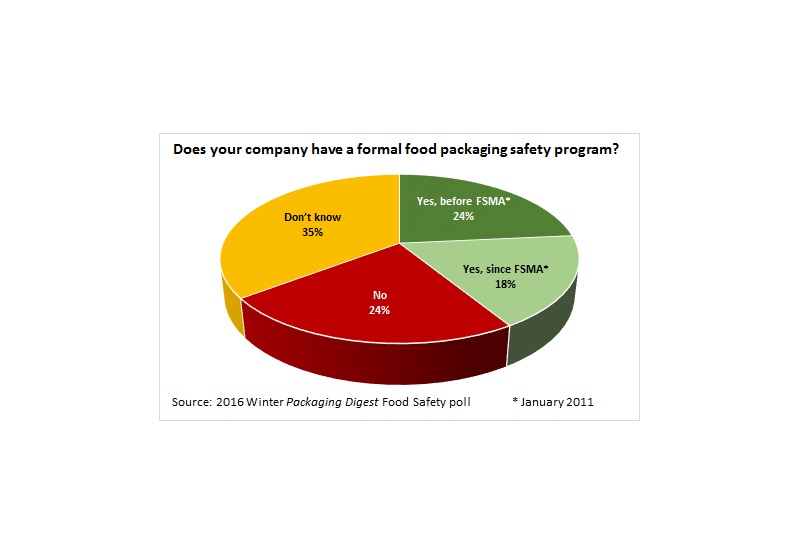February 9, 2016

FSMA implementation seems to have an overall effect of awareness on the part of packaging customers, which is impacting food packaging materials suppliers and distributors. Is that reasonable?
I was pleased to see there is generally high awareness among packaging professionals for the need to address food safety, according to the results of a Packaging Digest poll on the Food Safety Modernization Act. Yet I am also surprised that nearly 60% of respondents are unsure if their facilities could pass a food and packaging safety audit (see chart above). Note: Chart figures do not add up to 100% due to rounding.
If that is true, it would be consistent with the information that my company, EHA Consulting Group, receives from clients who either have been asked to provide proof of a successfully-passed 3rd party audit or are being asked to submit to a 3rd party audit.
As we have come to understand, most callers have limited knowledge of and concerns about 3rd party food safety audit preparation and expectations and, as such, are looking for guidance. Most of the callers represent small businesses and are in need of evaluating their food safety preparedness against client expectations. They are also wary of costs and resources.
I have no doubt that non-conforming businesses are looking at the process of assessment, upgrade and compliance as a necessary nuisance. I haven’t heard anyone indicate that their company is driven to comply based on the desire to apply best practices or to protect their clients and the public from harm or contaminants. I get the sense that in general, manufacturers and distributors of packaging and other food-related non-comestibles consider themselves collateral victims of well publicized events occurring on the “edibles” side of the food industry, driving clients to ratchet up their food safety compliance requirements.
Publicized reporting of events is limited
Due to the limited number of publicized packaging-related food safety events, low or no histories of food-safety-related packaging-related complaints and other factors, food packaging suppliers don’t see their processes and products as being in the same risk categories as edibles. They are positive to the concept of adding or upgrading basic prerequisite programs to control food safety within their processes, but appear skeptical that failure to apply and validate full certified food/packaging safety programs adds measurable risk to the safety and suitability of materials within the greater customer supply chain.
Finally, there is the issue of controlling unsuitability wherein a packaging component or material is considered by a client or customer to be “unsuitable for the application” due to any number of factors cited by the affected party. A finding or assertion of unsuitability may or may not be directly linked in the formal sense to the safety of the food for human consumption, but nonetheless can lead to complaints, withdrawals, recalls or other costly remedies.
Best practices dictate that food packaging converters or suppliers apply a continuous improvement approach to their food safety and suitability control process. Therefore, I offer the following general strategies for beginning the continuous improvement process:
Communicate with customers in order to get a sense of their supplier food safety and suitability audit expectations, specifically what food and/or packaging safety program or criteria.
Obtain a copy of client targeted food and packaging safety program expectation manual(s) and review with an expert in order to fully understand how the requirements and best practices relate to your facilities and organizations ability to intake, convert and dispense materials deemed “safe” by an independent auditor.
Perform an internal HARPC or HACCP-based risk analysis comparing expectations against performance after digesting the individual sections of your clients’ food safety expectations. Prioritize those systems or processes where non-conformance with expectations or obvious gaps in the “observe and control” process leaves the organization open to liability. Examples include food packaging supplier’s failure to audit their own internal facilities or incoming products for physical, chemical or microbiological contamination or the failure of a converter or distributor to implement best practices-driven procurement processes for identifying and certifying approved suppliers of incoming goods against their ability to meet comprehensive material specifications.
The above activities require championing and commitment. The rewards are in the application of continuous food safety program improvement and a demonstration to internal and external supply chain members that packaging materials quality, safety and suitability is a high priority and that your organization is committed to meet or exceed global safety standards.
Whether compliance has to be accomplished immediately or longer term, the advice is the same: Keep working at it!
Gary Kestenbaum has 40 years’ experience in the food and packaging industries, six as a supplier with National Starch, 18 as a product developer with General/Kraft Foods and 15 as a packaging engineer and developer with Kraft. As senior food packaging safety consultant with EHA Consulting Group, Kestenbaum provides guidance on packaging safety and suitability-related projects for raw material manufacturers, converters and associated supporting professionals. He can be reached at [email protected] or 410-484-9133. The website is www.ehagroup.com.
About the Author(s)
You May Also Like




